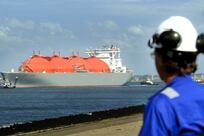ABU DHABI // Rock formations found in eastern parts of the UAE and Oman could help reduce carbon dioxide emissions by soaking up the harmful gas, a team of scientists believe. Peridotite, a rare rock which has been forced up from the earth's mantle, is being tested as a "carbon capture" material by researchers at Columbia University in New York. Contact between carbon dioxide and peridotite causes a chemical reaction which, over time, converts them into minerals such as calcite. The scientists hope that pumping carbon dioxide captured from power stations into the rock can significantly cut amounts released into the air. Prof Peter Kelemen, a geologist at Columbia, said: "We're talking about billions of tons of carbon dioxide a year. We have some very promising theoretical calculations." He speculated that injecting the rock with heated water containing carbon dioxide could speed up the gas-trapping process. He estimated that the process could soak up four billion tons of the gas a year - about 10 per cent of the carbon dioxide produced through human activity a year. Prof Kelemen said one possibility for the use of the rock could be to inject heated water containing carbon dioxide. Heating the rock could speed up the gas-trapping process by a million times or more. Researchers had ruled out as too costly an earlier plan to mine peridotite and ship it to nearby power stations. He said the team was still studying whether the porous rocks would stop absorbing the harmful gases once they are "clogged", or whether the peridotite would break apart. Other "carbon capture" methods involve pumping carbon dioxide into underground cavities, such as mineshafts and spent oil fields. The advantage of peridotite would be the elimination, through conversion, of the greenhouse gas. Jon Rodd, the general manager of exploration and production at ESG Dubai, an oil and gas company, said: "If you've driven through Hatta, you've probably seen a lot of the stuff." Peridotite has a rich dark red colour when it is seen on the surface, after it has been weathered by wind and rain. But when chipped with a hammer, a fresh slab of peridotite will reveal a dark green, almost black coloured stone, Mr Rodd said. "It's seen where the old oceanic crust and the mantle has been thrust upward on to the continental plate," he said. "It's rare to see this kind of rock type." "It's already available in the UAE," according to Hamdi Kandil, a geologist who lectures at UAE University. "They are related to the border of the Oman mountains, and if you go to the eastern area of the UAE, you will find peridotite." Peridotite can also be found in California, Oregon, Montana, the Balkans and the Pacific islands of Papua New Guinea and New Caledonia. The findings are to be published in the Nov 11 edition of the Proceedings of the National Academy of Sciences. mkwong@thenational.ae jgerson@thenational.ae
Rock found in UAE and Oman could absorb CO2
Rock formations found in eastern parts of the UAE and Oman could help reduce carbon dioxide emissions by soaking up the harmful gas.
Editor's picks
More from the national





